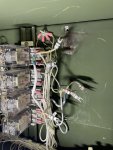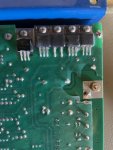Hi all,
I have the above set that I have had running well for over a year until about a month ago when it started to have the occasional overspeed then a hard overspeed whenever you tried to start it. Also at this time I noticed my voltage regulator was no longer working correctly and you could not control the voltage in the short time It would run. The situation is now, start the unit as normal, it revs very high, and shuts down via overspeed. Obviously it is actually in overspeed but I cannot figure out why. Things I have done so far.....
I replaced the voltage regulator with one from Kloppk and that is working great now...
1. Checked the transducer voltage at the Woodward controller, 2.46VAC.
2. Pulled and cleaned the transducer and reset it for the same voltage.
3. Replaced the transducer as the old one had a few scratches, tested voltage again at the controller.
4. Ran through all the troubleshooting tests for the woodward controller in the TM and all pass except it puts out a very high voltage to the actuator. It immediately shoots to somewhere in the 20V range before the unit shuts down.
To me the actuator seems to be ok as when you put power to it, it moves, but when they fail do they just go to max travel? I would assume they would just not work but who knows. So I think my problem is with the controller or the actuator. The actuator is made by woodward.
One other thing to note is when the unit starts the frequency gauge on the front rails out, then bounces around a bit but never back to "normal". Unit is set for 60hz but does the same thing at 50hz. I can only run it about 10 seconds in this condition.
Regards,
Jason
I have the above set that I have had running well for over a year until about a month ago when it started to have the occasional overspeed then a hard overspeed whenever you tried to start it. Also at this time I noticed my voltage regulator was no longer working correctly and you could not control the voltage in the short time It would run. The situation is now, start the unit as normal, it revs very high, and shuts down via overspeed. Obviously it is actually in overspeed but I cannot figure out why. Things I have done so far.....
I replaced the voltage regulator with one from Kloppk and that is working great now...
1. Checked the transducer voltage at the Woodward controller, 2.46VAC.
2. Pulled and cleaned the transducer and reset it for the same voltage.
3. Replaced the transducer as the old one had a few scratches, tested voltage again at the controller.
4. Ran through all the troubleshooting tests for the woodward controller in the TM and all pass except it puts out a very high voltage to the actuator. It immediately shoots to somewhere in the 20V range before the unit shuts down.
To me the actuator seems to be ok as when you put power to it, it moves, but when they fail do they just go to max travel? I would assume they would just not work but who knows. So I think my problem is with the controller or the actuator. The actuator is made by woodward.
One other thing to note is when the unit starts the frequency gauge on the front rails out, then bounces around a bit but never back to "normal". Unit is set for 60hz but does the same thing at 50hz. I can only run it about 10 seconds in this condition.
Regards,
Jason






